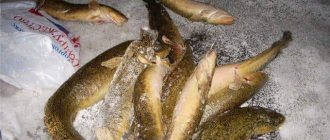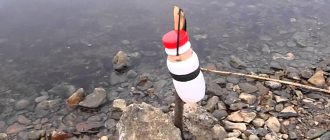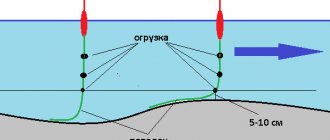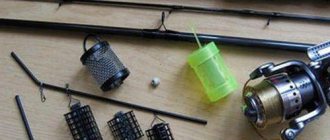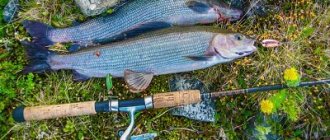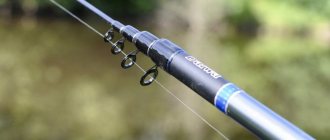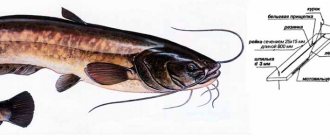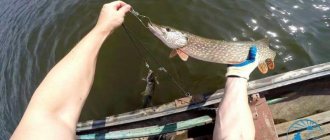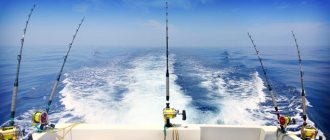Information
Characteristics
It is better to fish with a running donkey where a float wire rod will not help. This tackle can be used at any depth, in fast currents and on uneven bottoms. It is clear that in this way they catch fish that float on the current. It’s good to fish from a boat, but some, having chosen a convenient place, cast gear from the shore.
Half-bottom or catching by knock
In early spring, catching a catch with a float rod is not easy, due to factors such as strong currents and water pollution with debris. And yet, during this period, the fish are close to the shore, which negates the need to use bottom fishing rods; in addition, they are not so efficient. Basically, spring fishing is characterized by good catches; fish such as ide, perch, roach and bream are good for biting. The best option when fishing in high water is half-bottom fishing or “knock” fishing. For these purposes, there are two main types of fishing rod layout. If the distance from the shore is small and the current is not strong, then you can use a standard float rod. The float can move up about half a meter from the tip of the rod, so instead of two sinkers, one is used, usually sliding. This arrangement is not much different from a standard bottom, the only thing is that the sinker should be lighter and the line thinner.
When catching, a main line with a diameter of 0.3 mm is used, and leads no thicker than 0.17 mm. The weight of the sinker should not exceed the values revealed during the rod test. For a branded rod, the test is indicated on the butt. Using simple fishing rods, you can only rely on your skill.
If the sinker is too heavy, it can break the fishing rod, and if it is too light, then the catch may not take place at great depths or in the case of a fast river flow. The optimal weight can be determined through several tests. To do this, it is desirable that the sinker has a fastener, which will help you quickly change the sinker of one weight to another. With this arrangement, the length of the working line should be slightly longer than the length of the rod, due to the fact that the float in the upper part limits the reeling.
If you need a longer line, then the float is removed, and the bite can be determined by the tip of the rod. This design is in many ways similar to the English bottom fishing rod (quivertip), only a simplified variation. The quivertip is completely suitable for bottom fishing, designed for a wide range of used loads, and for the use of feeders of different shapes and sizes. Its design makes it possible to fish at any current speed and at different depths. Even standard spinning and wire rods remain effective when fishing “by knock” and give a good catch. In spring, the main bait is considered to be an earthworm, which fish love very much.
This is interesting: Chod-rig equipment
Donka short on a small river
Photo: Andrey Yanshevsky.
Now, when the water of small rivers drops, an excellent period for catching white fish begins here.
At this time, bream, roach and crucian carp come close to the shore and prefer to stand in deep bays and barrels under steep banks.
Our republic is full of small rivers, and most of them contain a lot of large fish.
The best season for catching it is the end of spring, when the water is already quite warm, and for some people spawning has happened, while for others it is just beginning.
On Civil, for example, large crucian carp are active at this time, weighing up to two kilograms; on average, fish weighing 500–800 grams are found.
The rest of the year, when the water level drops to the summer level, it’s as if there are no fish in the river, and you won’t get a bite.
Crucian carp are caught before, during and after spawning, but the rest of the time it is very, very bad.
On another small river of ours, larger - the Mari Republic - bream and ide are caught in the falling water.
Here, in the summer, when the river enters the channel and becomes quite shallow, large fish are not caught at all, only bleaks and roaches.
Large roach are active in the spring Sura, and again - before the arrival of summer and the establishment of the summer level.
FISHING CONDITIONS AND EQUIPMENT
Spring fish, with the exception of bleak and chub, stay close to the bottom. Among other things, near the shore, and preferably in those places where the depth comes very close to this very shore. So you have to fish with a short line, and on top of that, at a considerable depth.
The question arises - what to choose as gear? Wiring fishing is the most advantageous here because of its dynamism and mobility. A feeder with bait is thrown above the fishing spot, and wiring is done from the feeder and downstream.
However, fishing with a float rod at great depths is not very convenient. You can, of course, use equipment with a sliding float, but such fishing in a fast current will very quickly get tiring.
In such conditions I prefer half-bottom. The half-bottom is a simple tackle. Here on the Volga they fish with a half-bottom in cases where the fish prefers to take bait from the bottom rather than moving with the flow. It is done simply by moving the float to the tip of the rod and casting the rig a short distance. The line is kept tight, and bites are “read” by the float hanging from the end of the rod.
I modernized a simple Volga half-bottom by adding a feeding weight to the equipment. The feeder is locked on the rig with a winding ring, followed by a leash with a hook.
It is important that the feeder slides freely along the fishing line, so the bites will be more noticeable. You can fish with such gear even in whirlpools, where the depth five meters from the shore is 3–5 meters.
Read the material “Wiring before and after the flood”
In the rig I use the main braided line. I like it because, unlike monofilament, it transmits the bite more clearly to the alarm, and hooks are much more effective due to the low stretch of the cord.
Porridge or just bread is filled into the feeder and some flavoring is dripped in - you can throw it in. The advantage of this tackle is that the hook with the nozzle is located close to the feeder, and the fish coming for bait quickly finds the hook.
ATTACHMENTS
The bait should contain a little of what you are going to use as bait. If we fish, for example, with pearl barley, then we need to fill the feeder with pearl barley grains.
At the very beginning of the spring season, when the water in the rivers is quite high and cold, animal baits work best - worms, maggots, larvae. During the period of falling water, which is accompanied by its warming up, plant baits begin to work better and better.
The hit of the season is undercooked barley, which stays on the hook better than any semolina or dough. It is equally good at catching large ide, crucian carp, bream and other serious fish. I put 2-3 pearl barley on a hook. No matter how well it stays on the hook, the ubiquitous little things keep knocking down the grains. In addition, a voluminous bait is more noticeable for large fish.
Read the material “For ides in April”
The Tsivil River is of greatest interest to lovers of half-bottom fishing in Chuvashia. Many fishermen constantly come here in the hope of catching a large crucian carp or chub. And I heard about fishing with the most unconventional baits in the context of fishing in Civil.
So, for example, one year a capricious chub pecked well at smoked sausage. Moreover, the chub is far from a child, from a kilo or more. Another time I heard about such an excellent bait as a chicken heart - crucian carp pecked well on it. In a word, the nozzle is rather a matter of our imagination and capabilities.
SPECIFICS OF ROAC FISHING
Good conditions for catching large roach on a half-bottom are available on the wonderful Kokshaga River. In the spring, the roach found here is quite large, sometimes up to a kilogram or more. Its best move is in receding water, that is, right now.
Roach likes to concentrate on Kokshag near the shore, in bays and pools. The current is not felt here as much as in the middle of the river, where the bottom cannot hold even a 150-gram load. The soroga most often finds itself on the edge, in the snags.
It comes close to the shore in the very early morning hours, even before sunrise. Pulling it out of the snags is also not an easy task. After performing a typical bite, when the hanging float twitches sharply and briefly, it immediately scuttles - and into the bushes. It is important to have time to hook before this maneuver, that is, from the very first pokes.
Read the material “How to catch a marten in a hollow”
Of the baits, roaches prefer pearl barley, and in early spring they prefer worms and maggots. She is sensitive to bait, but not capricious, the main thing is that there is something edible in the water.
SPECIFICITY OF CATCHING FOR SCALE SCALE
I purposefully go to Sura for breams. Here it is rare to find significant depth right under the shore, so you have to be content with shallow depth, but even here you can stumble upon the real kings of the bream pride.
| Photo: Kuznetsova Evgenia. |
Unlike roach, bream and white bream stand in the watering areas, sometimes very close to the shore. They can be scared away very quickly, so it is better to catch them alone, observing all the rules of camouflage and silence.
When the water begins to fall very quickly, the white breams perceive this very painfully and immediately run away to deeper places, from where it is impossible to reach them with a half-bottom, this is already the prerogative of the feeder.
It is difficult to confuse the bites of a white bream with someone else’s. The line, which is under tension, quickly loses tension and the float pulls it towards the rod. It's time to hook.
When it comes to bait, the white bream almost exclusively prefers maggots, with exceptions being made for worms.
SPECIFICS OF FISHING FOR CRUCCIAN RASS
For these you should go to Civil. This river has many faces, with the most varied conditions imaginable. And crucian carp is very unpretentious, has taken root well and is excellently caught in the strongest currents.
Fishing is carried out from the very bed of the river, which, fortunately, is seven meters away. The current here is like a mountain river, so you can put an additional weight in front of the feeding weight.
Read the material “Paradoxes of the third reality”
Crucian carp is well caught using beetle larvae: the thicker and nastier the larvae, the better the large crucian carp bites.
The crucian season, by the way, has not yet really begun. In the meantime, you can go with a half-bottom for roach and bream to the nearest small river.
According to the rules, tackle with a float, as in a half-bottom, is equivalent to float tackle, so you can fish without taking into account any prohibitions.
Sergey Semenov May 19, 2021 at 07:13
Rules for choosing gear
The unifying factor for all donks is the possibility of catching fish feeding in the bottom layer and from the bottom of the reservoir. But this does not mean that all donks are the same and that gear for the current also differs from each other.
The use of one or another equipment depends on:
- fishing conditions;
- season;
- distance to point;
- availability of watercraft.
There are also universal bottom tackles and, for example, they can fish with a feeder both from the shore and from a boat, both in summer and winter. But in each case, the advantages and disadvantages of the equipment manifest themselves, and in summer or autumn it is more convenient to fish from the shore to the feeder. But you can’t fish from the shore with a winter bottom, so when choosing equipment, all factors are taken into account.
It is easier to knit primitive hooks or nipples, but the fishing efficiency with such equipment is much lower, so you need to choose what is more important. Fishing with a boat is more convenient, because you can choose any place on the reservoir, but you need to use bottom gear with rods.
Fishing tactics
The process of fishing with a running donkey is most reminiscent of spinning fishing. After casting, the equipment is lifted from the bottom with a rod (or reel) and the current is allowed to drag it a certain distance, after which it is allowed to lie on the bottom for a while. To catch peaceful fish, calmer retrieves are used; for predators, baits are used in approximately the same way as jig baits in a spinning rod. If there are no active fish at the selected point, you can change the place, since searching for promising areas for fishing with a running bottom is much easier than with a feeder.
Photo 4. And here is the trophy!
At the slightest suspicion of a bite, most anglers prefer to immediately make a sweeping hook (after all, a fishing line is used, not a cord, and it, especially at long distances, tends to stretch greatly), since it is most often not possible to determine whether the fish has swallowed the bait well.
You can also fish this way from a boat. In this case, the possibilities of fishing in promising places are significantly expanded, since casting is not interfered with by coastal vegetation, and the equipment can be carried along the wall of reeds or around other promising points. The main thing is to ensure that you have suitable anchors in advance so that the boat does not get carried away by the current.
Main advantages of the method
Significant differences between the running option both from the usual donkey and from the feeder method of fishing provide this method with the following advantages:
- The ability to fish effectively in strong current conditions, which may not be possible with even the heaviest commercially available feeders.
- More active play of the bait, which is simultaneously influenced by both the retrieve performed by the angler and the current, which revives the bait, making it much more attractive to the predator.
- The method is well suited for determining where fish stay in unfamiliar bodies of water. After the location of the school has been determined, if desired and the current is not too strong, you can proceed to feeder fishing.
- The presence of several hooks allows you to quickly determine the most suitable bait or attachment in a particular situation.
- With a suitable sinker shape, the equipment turns out to be more resistant to snags than feeder rigs - a weight like a Tyrolean stick slips out of those places where the feeders get stuck.
- It is much easier for an angler to change the place of fishing than with feeder fishing. Often, fishing with a running donkey becomes exploration of an unfamiliar area for promising fishing spots and concentrations of fish.
Donks with feeders
3
When catching white fish using bottom gear, you need to use bait. To deliver complementary foods, feeders of any type and size are used, depending on the characteristics of the place (current, depth, etc.). Any feeder is a reservoir for storing bait with holes for slowly washing it out. The feeder can be used instead of a weight or used together with lead weights.
Spiral feeder with central sinker
The most used feeders are a spiral of steel wire with a diameter of 3 mm. When making a spiral used in areas with strong currents, one part of the spiral is filled with lead. As a rule, the feeder is attached to a fishing line, one leash is placed below the feeder, and the other above. To fill the spiral feeder, complementary foods are mixed with clay. Feeders made from a piece of aluminum tube with a diameter of 20-40 mm with drilled holes with a diameter of up to 4 mm are often used. The tube is closed at both ends with rubber plugs with holes for passing the fishing line. This design is called a “racket”.
Feeder “torpedo” (“racket”) 1-limiter; 2 rubber plugs with holes; 3-duralumin tube with holes; 4-leashes.
The equipped “racket” has a normal weight for fixing it on the bottom in a quiet current. In the case of a strong current, lead is placed inside the feeder or a pair of lead rings are fixed outside. The advantages of such a feeder are the large volume and low degree of feed leaching. Basically, feeders are filled with porridge and bran.
SOURCE
Reels you can use
A walking donkey is one of those fishing methods that is as undemanding as possible when it comes to the reels used. This could be a non-inertial reel taken from a spinning rod with a standard size from 2000 to 4000, or maybe an ancient inertial reel made 40 years ago. However, inertia-free fishing is still preferable, especially for anglers with little experience. Such coils are easy to use and rarely form “beards”.
Gasoline reels are the best choice for equipping a running bottom
If available, you can use at least multiplier ones, together with a spinning rod. Such rods are usually designed for the use of large baits, the test reaches 40 grams or more, and the fast action ensures good sensitivity.
This is interesting: Boat fishing
Suitable rods for running donkey
Fishing with a running bottom is not very demanding on the rods used. Both pickers and fast-action spinning rods with a test weight of up to 40 grams, or better yet 50–60, are suitable; lighter weights simply will not hold the bottom in the current. Preference should be given to fast rods, as they allow you to make any type of fishing, including in strong currents, and will also provide sufficient sensitivity when biting.
Typically, fishing rods up to 2.3–2.7 meters long are used; longer options are considered inconvenient. Usually, such forms are quite enough to cast to the required distance, but in the case of 3.6-meter feeders, maneuvering in many places with such rods can be difficult.
Advantages of the fishing method
Fishing with a running donkey has its own characteristic features, which are best manifested in conditions of spring water level rise:
Donk fishing rod
- Suitable for strong currents. There are situations when even 150-gram feeders do not hold the bottom. A correctly shaped sinker copes with this task better.
- Allows you to quickly explore unfamiliar areas and determine where fish accumulate.
- This is a universal tackle. Suitable for both peaceful and predatory fish - you just need to choose the right bait.
- Fishing with a running donka does not require expensive specialized rods or reels.
Exciting fishing with a running donkey
Some rivers have a fairly strong current, which becomes especially noticeable during the spring rise in water levels. Often in such a situation, even the use of extra heavy class feeders and the heaviest feeders is not enough for successful fishing. In such situations, the running donka helps out. This gear allows you to quite successfully catch both peaceful and predatory fish even in the strongest currents, since this method does not imply that the equipment is constantly located at one point. Instead, hooks with a nozzle lead at a faster or slower pace, depending on what specific type of fish is being hunted - if the object being fished is a predator like perch, then the wiring resembles a spinning jig; for white fish, slower options are used , however, in both cases the flow directly affects the game.
Fishing with a running donka from the shore
You need to fish from the shore in the following way: you need to throw a heavy sinker with bait into a fast current, so that when it falls to the bottom, the sinker stretches the line so that it is perpendicular to the shore. In principle, fishing is the same as from a boat. You should tug the line from time to time while lifting the sinker so that the current carries your equipment a distance. If after several trips there are no bites, then it is better to change the fishing location, and upstream.
A couple more tips for donk lovers, here!
By the way, you can fish using the principle of a running donkey even in winter, through a hole. Yes, yes, there is a “slide” through the hole to the donk, read here.
Fishing on a donk
Initially it was hand tackle without reels and rods. Then a feeder appeared that included the missing parts. The efficiency of fishing has increased several times, as it has become easier to catch fish from the water.
For a good catch you will need several gears. Their number can exceed ten. To prevent the line from getting tangled, the distance between the baits in the water should be more than 5 meters. Carp and catfish are often caught using bottom gear. The fish are quite large, so fix the rod well.
How does it work
Bottom tackle is a fishing rod fixed on the shore. Throw bait into the water. As soon as the fish is caught, hook. For efficiency, professionals use alarms and feeders. The following are selected as alarms:
- Bells.
- Electronic signaling devices.
- Bells.
- Rod. In this case, the tip of the fishing rod begins to bend. Well suited for feeders. This version of the alarm is intended for daytime fishing, since at night it is difficult to see the bending of the rod tip.
Where to fish for donka
Choose a place without underwater snags and plants. The bottom type can be anything except stone. It is more effective to fish at night. Catching areas are not far from dams or bridges; there is always more food there.
The main fish that fishermen with bottom tackle hunt for is catfish. Catfish is a large fish, sometimes its volume can reach half a meter, and its weight can be more than 30-50 kilograms. Therefore, you need to take care of the secure fixation of the donkey, so that after a while, when you come to check “Is there anything on the hook?” - you didn’t see the empty space and the absence of a fishing rod.
Baits used
Not all baits are suitable for this method of fishing. Too soft options, such as, for example, semolina or bread, will quickly fly off the hook even if fishing takes place in still water. In this regard, the following baits and attachments are mainly used:
- red dung worm;
- maggot;
- live bait;
- pasta;
- pearl barley.
Important! To prevent the red dung worm from slipping off the hook, it can be secured with maggots. Among other things, such a “sandwich” often works better than maggots or worms individually.
But bait is usually not used. After all, the equipment does not remain in one place, and the current is not conducive to the use of bait mixtures - anyway, in such conditions they are ineffective, since the food is either washed away by the current, or the hooks with bait leave the feeding point during the retrieve.
Equipment Features
The equipment of the chassis itself is quite simple. The tackle consists of a sinker and several leashes with hooks. To make the leashes less tangled, they are attached to the main line using swivels, or anti-twist tubes are used. The load may be positioned differently. Most often, it is simply tied to the end of the main line, but there are options for attaching the sinker to a separate leash, or tying it in front of the leashes. Each of the designs has its own advantages and disadvantages.
Important! The passability of the equipment can be increased if you use not an ordinary sinker, but, for example, a Tyrolean stick.
As a leader material, a slightly thinner fishing line is generally used than the main one. Fluorocarbon is occasionally used, and in places where there are a lot of pike (especially if there is live bait on the hook instead of a worm), steel wire leashes can also be used.
The main line is often set quite thick, from 0.3 to 0.4 millimeters, since in such a case the current will put more pressure on the equipment and will have a positive effect on the performance of the bait. Also, the large diameter allows you to pull out the tackle when snagged, and also provides the ability to fight large fish.
Sinkers are used in pear-shaped, flat, or so-called Tyrolean sticks - this way, maximum maneuverability on a rocky or snagged bottom is achieved. On reservoirs with weak or no current, you can also use a spring weight filled with viscous bait.
Photo 3. Flat sinker of suitable weight.
Method of equipping the chassis
There are several ways to rig a donkey. The most popular of them is the classic one.
Read more
What is a donka for pike?
The assembly diagram of the running bottom consists of a sinker with a through hole, limiters and a leash with hooks.
The main thing in this process is to choose the “right” sinker. You need to focus on the weight and shape of the element. These parameters directly depend on factors such as water depth, current speed, and angler preferences.
Fishing with this gear differs from feeder fishing mainly in the rods used and tactics.
The tasks of the sinker should be:
- reliable fixation of the bait;
- maneuverability;
- versatility (it should not cling to grass, stones and other elements).
It is recommended to give preference to products made from lead.
For effective fishing, choose a conical or cylindrical sinker; the “spoon” shape is also popular. The product is not fixed to allow it to slide (it is enough to just put stops on both sides). You should pay attention to the thickness of the fishing line. This parameter depends on the size of the expected fish caught.
Leashes with hooks are located above and below the sinker.
Donks with installed anti-twisters, the shape of which can be varied, are becoming quite popular. The purpose of the design is to use a special tube that prevents the line from getting tangled and the leashes from getting tangled.
Varieties of donks for currents
The following are considered catching gear for the current:
- classic donka with a rod and spring;
- casting without a rod;
- running donka;
- carousel;
- "crucian carp killer";
- donka for fishing from a boat with a ring;
- feeder tackle (including method);
- makushatniks;
- donks on a predator;
- "nipples".
The main difficulty when fishing on the current is to choose the right sinker. You should not use a load that is too heavy, but it should not be carried away by the current either. The weight of the load should be such that the tackle lies on the bottom in a calm state, but upon contact with the fish it immediately transmits information about this to the fisherman. A cautious fish, having picked up and pulled a leash with a heavy load, will immediately become wary, drop the bait, and no hooking will occur.
Choosing a place for fishing with a running donkey
It is very important for us to find a place on a reservoir with a flat bottom, without stones and grass. It’s great if it’s a carpet of shells or sand, so that the nozzle evenly covers the entire distance. The depth at the fishing spot can vary significantly. This is one of the advantages of a running donkey over a float tackle. The depth can be 4 or 5 meters, and it can vary significantly along the entire wiring path.
If we fish from the shore, we choose areas with good access to the water. Fishing in this way involves frequent changes of places and it is desirable that there are trees and bushes and access to water. If there is a wall of reeds along the shore, then it is better to fish from a boat. We avoid areas with silt, since in such places the angler’s contact with the gear will be poor. The sinker will continually sink. Only a hard bottom is suitable for our fishing
Requirements for bottom gear
The main requirements for any bottom current equipment:
- sensitivity;
- functionality;
- compactness;
- reliability.
Strong river fish breaks off incorrectly tied and unreliable equipment, and the fisherman is left without a trophy. Therefore, each element of the donkey must be functional and durable. This applies to fishing lines, hooks and rods, and all components are responsible for their functions.
It is not necessary to purchase the most expensive gear, but its reliability must correspond to the assigned tasks. Another advantage of fishing with donks in the current is that the fisherman can only guess how big the fish he will catch will be.
When fishing for crucian carp or bream, carp and even catfish are caught on the hook, and this fish is much larger and more powerful. Therefore, it is important to be ready for the trophy, and this depends on the reliability of the gear.
The interchangeability of elements in the equipment is also important, because fishing conditions vary, and sometimes you have to change weights or leashes due to cliffs or weather conditions. If the bite is good, you don’t want to waste time on such things, and it’s better to take a supply of rigs with you.
Unusual spring fishing. Running donka
Do you love early spring river fishing as much as I do? Floating ice floes trying to catch the fishing line, grass and debris carried by the current, the water level rising by several meters, because of which it is not clear where to look for fish, is that all? But seriously, right now is the most fertile time for catching trophy whitefish, primarily chub, ide, large roach, dace - fish that still stick to large schools and feed very actively in anticipation of the imminent spawning.
As a rule, the main equipment for such fishing is a Bolognese fishing rod and a feeder. However, even they are sometimes not able to give the angler the opportunity to successfully fish on a river stream: try fishing here in a pit remote from the shore, when the current carries debris and it is not possible to keep the feeder at the point for longer than 15-20 seconds. The lap dog also remains out of work - it is almost impossible to throw the float at a distance of about 30-35 meters and make clear wiring. We need to think about something!
What is a running donka?
This is where the running donka shows itself in all its glory. Representing, in fact, a symbiosis of a lapdog and a feeder, it provides the possibility of contact fishing at distances of up to 45 meters, without requiring special skills from the angler and, in fact, doing everything for him.
Under this term, in my understanding, the classic feeder tackle is clearly rooted, in which the feeder is replaced by a compact sinker weighing from two to four ounces. It is selected experimentally depending on the strength of the current. With the correct weight of the sinker, the equipment moves along the bottom at a speed that is somewhat slower than the speed of the current.
A running donka is a search method that does not require the use of bait and involves frequent movement of the fisherman along the river. Unlike the Bolognese tackle, when fishing with which the coastal topography plays a huge role, forming the stream, the running donka is absolutely undemanding when choosing a fishing point and shows its best side even on a straight, flat run, devoid of any anomalies and changes in depth. It is here that in early spring you can often find schools of white fish moving downstream to their future spawning sites.
Preparatory procedures for fishing with a running bottom are traditional for fishing with a feeder. First of all, the angler determines a promising area for fishing. This could be a groove, a small rise, a sand spit, or another interesting place on the bottom, which the fish adheres to at a particular moment in time. The tackle is clipped and the angler begins fishing, casting the rig perpendicular to the current and letting the stream carry it to the shore in a wide arc. If the sinker is selected correctly, the duration of one cast is from 2 to 4 minutes, depending on the strength of the current and casting distance.
Things are somewhat different when the bottom relief is the same throughout the cast and there is nothing to attach to. In this case, I use the search method, starting fishing near the shore and gradually moving away from it, taking steps of 1-1.5 meters until I determine the distance at which the fish is located. In the future, this distance is worked out, and casts are made not only along the landmark, but also to the left and right, due to which the trajectory of the equipment changes, and the angler gets the opportunity to fish a specific place more fully.
What gear is used for this kind of fishing?
- The rod is a classic medium class feeder, 3.6-3.9 meters long and weighs up to one hundred grams. But only in the case when fishing is planned exclusively using this method, and the fisherman does not need to throw river feeders weighing 100-120 grams or more. In such a situation, you will have to resort to the help of a heavy feeder or use two tackles, switching between them if necessary. I described how to choose a river feeder in an article of the same name;
- The reel is matched to the fishing rod. In my case, it is a four-thousander with a rear drag and a fine match spool with a gear ratio of 4.8:1;
- The installation is based on a braided cord number 1.0 (conventional diameter 0.1 millimeters), on which a paternoster is knitted as a rig. For such fishing, this installation is universal - the sinker drags along the bottom, while the leash floats slightly above the bottom under the influence of the jet. Exactly as long as your lead arm is;
- The leash has a length of 60-70 centimeters and a diameter of about 0.12-0.14 millimeters, the hook is selected based on the bait used (I have already talked about the most commonly used river baits, the recommendations for a running bottom are similar);
- In addition, the angler should have a supply of tackle that includes several different types of hooks, several skeins of fishing line with a diameter of 0.12 to 0.16 millimeters, as well as a set of sinkers weighing from 1 to 4 ounces in increments of 0.5 ounces (14 grams).
What to take with you when fishing using a walking donkey?
Spring fishing with a running donkey, despite high mobility and frequent transitions from place to place, assumes that the angler can stay in one place for one or several hours. And given that the ground is still frozen, you will need a simple set of equipment and additional accessories.
First of all, we are talking about a compact chair or stool that does not take up much space in luggage and is installed in a matter of seconds, and, being disassembled, will not cause inconvenience during the transition. Secondly, you cannot do without a tripod to install the rod: the butt always lies on the knee, but the whip must be fixed in a static position. You can also use a poke, but only when the ground has thawed and allows you to stick it in.
You also need to think about a bag or backpack that will be used to carry a set of equipment and containers with attachments. Sufficient volume, a large number of external pockets, a comfortable belt or harness for transportation - these are the basic requirements for a high-quality backpack.
Such a set of equipment is quite enough to feel a sufficient degree of comfort without compromising mobility and mobility.
Tackle without rods for current
There are current donks that do not have a rod in their design, these include:
- "rubber bands";
- snacks;
- carousels.
The advantages of such donks are their compactness, because they are more convenient to transport and store due to their small size. The reels on which such donks are wound have a design that allows them to be secured to the shore and held firmly.
When a river fish bites strongly, there is a chance that the tackle will be pulled into the water, so you need to secure it well and monitor the condition of the reel. They fish with donkeys without rods from the shore; it is more convenient both for casting and controlling the tackle, and for fishing.
Inertia-free reels, which are required for a feeder, are not needed on a cast or elastic band; this simplifies the design of the tackle, but complicates pulling the fish to the shore.
Rubber
The design of the elastic band throw for the current has a rubber shock absorber, thanks to which you don’t have to throw the tackle all the time, it goes into the water itself, and in the right place.
The disadvantage of fishing with a bottom rubber band in the current is that the shock absorber is stretched under water pressure and it is difficult to achieve good accuracy. An elastic band is more of a tackle for still waters, although there are many anglers who use it on rivers with a current.
Carousel
The tackle is similar to an elastic band in that it is equipped with 5–10 leashes with hooks, there is no fishing rod, the load is carried on a boat and the equipment is pulled into the water. Let's imagine a double-tied fishing line stretched into the eye of a weight located at the bottom of a reservoir.
When one of the parts is pulled, the other, to which the leashes are attached, also moves and goes into the water. After this, the fishing line is fixed on the reel, the alarm is set and all you have to do is wait for the bite. After the alarm goes off, all you have to do is pull the fishing line with hooks, and it will go to the shore, pulling the other end into the water.
After the angler removes the caught fish and re-hooks, the process is repeated. The donka carousel is more convenient for the current than an elastic band, because it does not stretch out in the water, but it is difficult to catch trophy fish with it due to the roughness of the equipment.
Mushrooms and nipples
Similar multi-hook rigs are used both in still waters and in currents and show good results. True, you will have to be patient and wait for a bite, because the principle of operation of the gear is based on the fact that the bait or a cube of macaque is washed away and attracts fish.
Having come to feed, the fish are hooked with one or more hooks on which foam is mounted, providing good buoyancy. The fluff takes a long time to wash away, and bait in the nipple is not much faster, although when fishing in the current this process is, for obvious reasons, accelerated.
But trophy fish are caught both on tops and nipples, which are not afraid of noise on the shore or rough elements of equipment. So such gear is used for fishing in the current, with or without a rod and reel, on hooks.
Equipment
The rod is mounted with a reel and a supply of main fishing line. A triple swivel is attached to the fishing line, and two leashes are attached through the winding rings. The length of one leash is up to 1 m, and the other – up to 50 cm. This design allows the fisherman to use two types of bait at the same time, but the disadvantage is the difficulty of casting. The sliding sinker is located on the main line or undergrowth.
The undergrowth is usually 30-50 cm long from a piece of fishing line 0.3-0.35 mm, at the ends of which there are loops. The main fishing line is attached to the topmost loop of the leader through a secure fastener. In this case, the leader is easily removable; you can keep a supply ready and quickly change them during active fishing. Sometimes an end leash (10-12 cm) from a piece of 0.2 mm fishing line is attached to the bottom loop, but most often they fish without it - a pair of working leashes are attached to a wire outlet.
Feeders are often used in the equipment of the undercarriage.

